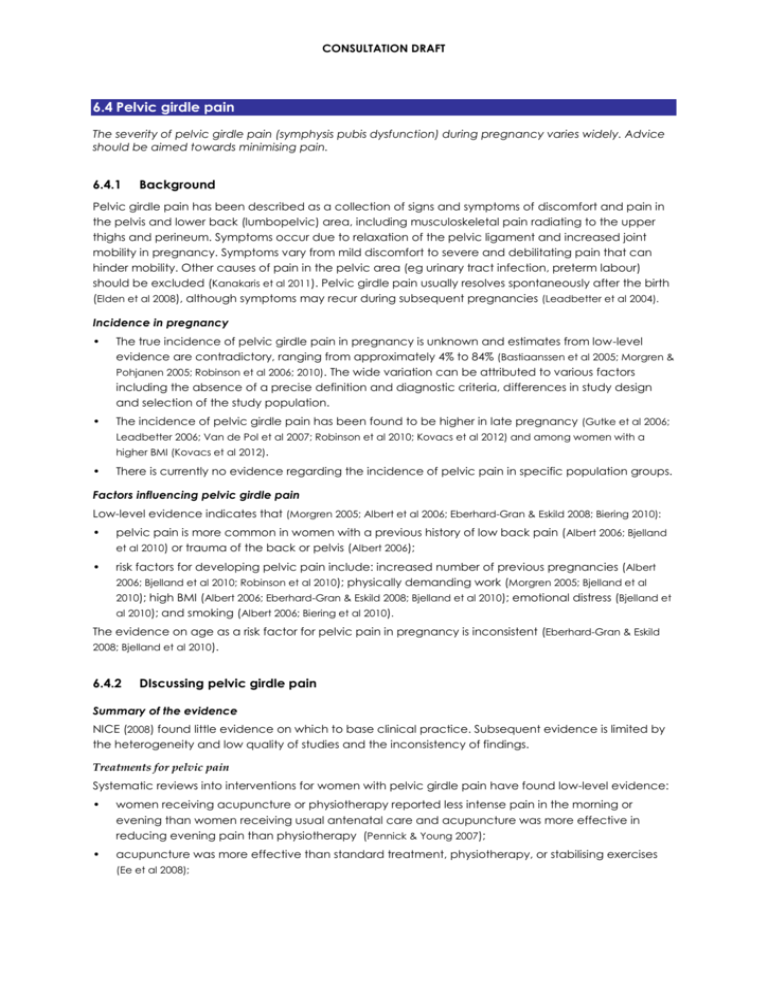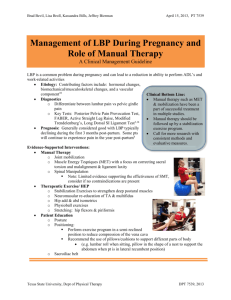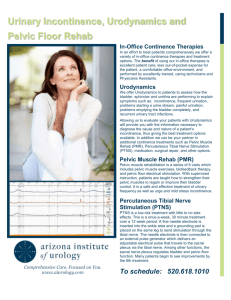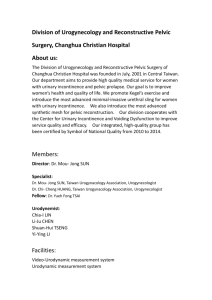Treatments for pelvic pain
advertisement

CONSULTATION DRAFT 6.4 Pelvic girdle pain The severity of pelvic girdle pain (symphysis pubis dysfunction) during pregnancy varies widely. Advice should be aimed towards minimising pain. 6.4.1 Background Pelvic girdle pain has been described as a collection of signs and symptoms of discomfort and pain in the pelvis and lower back (lumbopelvic) area, including musculoskeletal pain radiating to the upper thighs and perineum. Symptoms occur due to relaxation of the pelvic ligament and increased joint mobility in pregnancy. Symptoms vary from mild discomfort to severe and debilitating pain that can hinder mobility. Other causes of pain in the pelvic area (eg urinary tract infection, preterm labour) should be excluded (Kanakaris et al 2011). Pelvic girdle pain usually resolves spontaneously after the birth (Elden et al 2008), although symptoms may recur during subsequent pregnancies (Leadbetter et al 2004). Incidence in pregnancy • The true incidence of pelvic girdle pain in pregnancy is unknown and estimates from low-level evidence are contradictory, ranging from approximately 4% to 84% (Bastiaanssen et al 2005; Morgren & Pohjanen 2005; Robinson et al 2006; 2010). The wide variation can be attributed to various factors including the absence of a precise definition and diagnostic criteria, differences in study design and selection of the study population. • The incidence of pelvic girdle pain has been found to be higher in late pregnancy (Gutke et al 2006; Leadbetter 2006; Van de Pol et al 2007; Robinson et al 2010; Kovacs et al 2012) and among women with a higher BMI (Kovacs et al 2012). • There is currently no evidence regarding the incidence of pelvic pain in specific population groups. Factors influencing pelvic girdle pain Low-level evidence indicates that (Morgren 2005; Albert et al 2006; Eberhard-Gran & Eskild 2008; Biering 2010): • pelvic pain is more common in women with a previous history of low back pain (Albert 2006; Bjelland et al 2010) or trauma of the back or pelvis (Albert 2006); • risk factors for developing pelvic pain include: increased number of previous pregnancies (Albert 2006; Bjelland et al 2010; Robinson et al 2010); physically demanding work (Morgren 2005; Bjelland et al 2010); high BMI (Albert 2006; Eberhard-Gran & Eskild 2008; Bjelland et al 2010); emotional distress (Bjelland et al 2010); and smoking (Albert 2006; Biering et al 2010). The evidence on age as a risk factor for pelvic pain in pregnancy is inconsistent (Eberhard-Gran & Eskild 2008; Bjelland et al 2010). 6.4.2 DIscussing pelvic girdle pain Summary of the evidence NICE (2008) found little evidence on which to base clinical practice. Subsequent evidence is limited by the heterogeneity and low quality of studies and the inconsistency of findings. Treatments for pelvic pain Systematic reviews into interventions for women with pelvic girdle pain have found low-level evidence: • women receiving acupuncture or physiotherapy reported less intense pain in the morning or evening than women receiving usual antenatal care and acupuncture was more effective in reducing evening pain than physiotherapy (Pennick & Young 2007); • acupuncture was more effective than standard treatment, physiotherapy, or stabilising exercises (Ee et al 2008); CONSULTATION DRAFT • exercise, pelvic support garments and acupuncture improved functional outcomes (Richards et al 2012); and • exercise during pregnancy may decrease pelvic girdle pain (Schiff Boissonnault et al 2012). RCTs have found benefits from a multimodal approach (manual therapy, stabilisation exercises, patient education) (George et al 2012) and no reduction of pain with exercise (Eggen et al 2012; Stafne et al 2012). Lower level evidence supports acupuncture as an effective intervention (Ekdahl & Petersson 2010). No serious adverse effects were reported (minor side effects included bruising, pain on needle insertion, bleeding, haematoma and fainting). Recommendation 11 Grade C Advise women experiencing pelvic girdle pain that pregnancy-specific exercises, physiotherapy, acupuncture or using a support garment may provide some pain relief. Advice on managing pelvic girdle pain There is consensus from low-level evidence and clinical reviews about providing advice on minimising pain, including (Vleeming et al 2008; Leadbetter et al 2004; Aslan & Fynes 2007): • wearing low-heeled shoes; • seeking advice from a physiotherapist regarding exercise and posture; • reducing non-essential weight-bearing activities (eg climbing stairs, standing/walking for long periods of time); • avoiding standing on one leg (eg by sitting down to get dressed); • avoiding movements involving hip abduction (eg getting in/out of cars, baths or squatting); and • applying heat to painful areas. 6.4.3 Practice summary: pelvic girdle pain When: A woman has pelvic girdle pain. Who: Midwife; GP; obstetrician; Aboriginal and Torres Strait Islander Health Practitioner; Aboriginal and Torres Strait Islander Health Worker; multicultural health worker, physiotherapist. Provide advice: Reassure the woman that pelvic girdle pain will not harm her or her unborn child, and is likely to resolve after the birth. Advise the woman about steps she can take to minimise pain. Take a holistic approach: Consider possible barriers to women being able to make changes to minimise their pain (eg work requirements, cultural attitudes to exercise, costs of allied health services). 6.4.4 Resources Common discomforts in pregnancy. In: Minymaku Kutju Tjukurpa Women’s Business Manual, 4th edition. Congress Alukura, Nganampa Health Council Inc and Centre for Remote Health. http://www.remotephcmanuals.com.au 6.4.5 References Albert H, Godskesen M, Korsholm L et al (2006) Risk factors for developing pregnancy-related pelvic girdle pain. Acta Obstet Gynecol Scand 85: 539–44. Aslan E & Fynes M (2007) Symphysial pelvic dysfunction. Current Opinion in Obstetrics and Gynecology 19(2): 133139. Bastiaanssen JM, de Bie RA, Bastiaenen CHG et al (2005) Etiology and prognosis of pregnancy-related pelvic girdle pain; design of a longitudinal study. BMC Public Health 5: 1–8. Biering K, Aagaard Nohr E, Olsen J et al (2010) Smoking and pregnancy-related pelvic pain. BJOG 117( 8): 1019–26. Bjelland E, Eskild A, Johansen R et al (2010) Pelvic girdle pain in pregnancy: the impact of parity. Am J Obstet Gynecol 203(2): 146.e1–e6. CONSULTATION DRAFT Depledge J, McNair P, Keal-Smith C et al (2005) Management of symphysis pubis dysfunction during pregnancy using exercise and pelvic support belts. Phys Ther 85(12): 1290–300. Eberhard-Gran M & Eskild A (2008) Diabetes mellitus and pelvic girdle syndrome in pregnancy – is there an association? Acta Obstet Gynecol Scand 87: 1015–19. Ee C, Manheimer E, Pirotta M et al (2008) Acupuncture for pelvic and back pain in pregnancy: a systematic review. Am J Obstet Gynaecol 198(3): 254–59. Eggen MH, Stuge B, Mowinckel P et al (2012) Can supervised group exercises including ergonomic advice reduce the prevalence and severity of low back pain and pelvic girdle pain in pregnancy? A randomized controlled trial. Phys Ther 92(6): 781–90. Ekdahl L & Petersson K (2010) Acupuncture treatment of pregnant women with low back and pelvic pain — an intervention study. Scand J Caring Sci 24: 175–82. Elden H, Hagberg H, Olsen MF et al (2008) Regression of pelvic girdle pain after delivery: follow-up of a randomised single blind controlled trial with different treatment modalities. Acta Obstet Gynecol Scand 87(2): 201–08. George JW, Skaggs CD, Thompson PA et al (2012) A randomized controlled trial comparing a multi-modal intervention and standard obstetrical care for low back and pelvic pain in pregnancy. Am J Obstet Gynecol 1: S360. Gutke A, Ostgaard H, Oberg B (2006) Pelvic girdle pain and lumbar pain in pregnancy: a cohort study of the consequences in terms of health and functioning. Spine 31(5): E149–55. Haugland KS, Rasmussen S, Daltveit AK (2006) Group intervention for women with pelvic girdle pain in pregnancy. A randomized controlled trial. Acta Obstet Gynecol Scand 85(11): 1320–26. Kanakaris NK, Roberts CS, Giannoudis PV (2011) Pregnancy-related pelvic girdle pain: an update. BMC Med 9: 15. Kovacs FM, Garcia E, Royuela A et al (2012) Prevalence and factors associated with low back pain and pelvic girdle pain during pregnancy: A multicenter study conducted in the spanish national health service. Spine 37(17): 1516–33. Leadbetter R, Mawer D, Lindow S (2004) Symphysis pubis dysfunction: a review of the literature. J Maternal-Fetal Neonatal Med 16: 349–54. Morgren I (2005) Previous physical activity decreases the risk of low back pain and pelvic pain during pregnancy. Scand J Public Health 33: 300–06. Morgren I & Pohjanen A (2005) Low back pain and pelvic pain during pregnancy: prevalence and risk factors. Spine 30: 983–91. Pennick V & Young G (2007) Interventions for preventing and treating pelvic and back pain in pregnancy. Cochrane Database Sys Rev 2007 Issue 2. Art. No.: CD001139. DOI: 10.1002/14651858.CD001139.pub2. Richards E, Van Kessel G, Virgara R et al (2012) Does antenatal physical therapy for pregnant women with low back pain or pelvic pain improve functional outcomes? A systematic review. Acta Obstet Gynecol Scand 91(9): 1038–45. Robinson H, Veierod M, Mengshoel A et al (2010) Pelvic girdle pain – associations between risk factors in early pregnancy and disability or pain intensity in late pregnancy: a prospective cohort study. BMC Musculoskeletal Dis 11(91): 1–12. Robinson H, Eskild A, Heiberg E et al (2006) Pelvic girdle pain in pregnancy: the impact on function. Acta Obstet Gynecol Scand 85:160–64. Stafne SN, Salvesen KA, Romundstad PR et al (2012) Does regular exercise during pregnancy influence lumbopelvic pain? A randomized controlled trial. Acta Obstet Gynecol Scand 91(5): 552–59. Stuge B, Hilde G, Vollestad N (2003) Physical therapy for pregnancy-related low back and pelvic pain: a systematic review. Acta Obstet Gynecol Scand 82(11): 983–90. Van de Pol G, Brummen J, Bruinse H et al (2007) Pregnancy related pelvic girdle pain in the Netherlands. Acta Obstet Gynecol Scand 86: 416–22. Vleeming A, Albert H, Ostgaard HC et al (2008) European guidelines for the diagnosis and treatment of pelvic girdle pain. Eur Spine J 17: 794–819.






